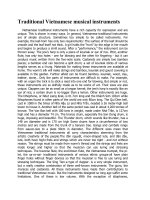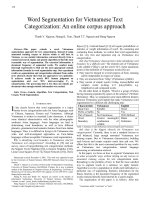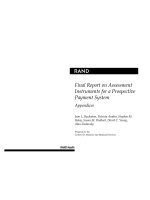Traditional Vietnamese musical instruments
Bạn đang xem bản rút gọn của tài liệu. Xem và tải ngay bản đầy đủ của tài liệu tại đây (1.16 MB, 27 trang )
Traditional Vietnamese musical instruments
Vietnamese traditional instruments have a rich capacity for expression and are
unique. This is shown in many ways. In general, Vietnamese traditional instruments
are of simple structure. Sometimes too simple to be called instruments. For example,
the leaf-horn has only two requirements: The surface of the leaf should be smooth
and the leaf itself not thick. A girl holds the "horn" by the edge in her mouth and
begins to produce a shrill sound. After a "performance," the instrument can be thrown
away. The jew's harp is only a piece of kouniak or ear of rice. Pitot, another flute, has
only two holes - one for blowing and the other for fingering - but it can produce music
written from the five-note scale. Castanets are simply two bamboo pieces; a bamboo
end can become a split drum; a set of kouniak sticks of various lengths serves as a
t'rung. Materials for making these instruments are available at home. The worm's silk
will make strings and bamboo, kouniak and gourd covering is available in the garden.
Further afield can be found bamboo, kouniak, wood, clay, leather, stonẹ.. Only the
parts of instruments are difficult to make. For example, with an organ the trick is to
stick a reed into one end for blowing. But simple or not, these instruments are so
skilfully made as to be works of art. Their sizes are also unique. Clappers can be as
small as a longan kernel; the jew's harp is exactly like an ear of rice; a certain drum is
no bigger than a lemon. Other instruments are huge. The lithophone, or Ndut Lieng
Krak, is 01.7cm long and the Khánh Sơn 103cm while lithophones found in other parts
of the world are only 80cm long. The Qui Dien bell, cast in 1080 in the times of Nhà
Hậu Lý and Nhà Trần, needed a 26 meter-high bell tower to house it. Another bell of
the same period was cast in about 4,200 tonnes of bronze. The Van Ban bell with 180
tons in weight, made under Nhà Trần, is 127cm high and has a diameter 74 cm. The
bronze drum, especially the Son Dong drum, is huge, imposing and beautiful. The
Thunder drum, which sounds like thunder, has a 148 cm diameter and is 170 cm high
Some drums have a circumference of two metres and are made from the trunk of a
banyan tree. Gongs and cymbals range from saucer-size to a plate 90cm in diameter.
The different sizes mean that Vietnamese traditional instruments all carry
characteristics stemming from the artistic creativity of the people.The đàn nguyệt,
moon-shaped lute, and đàn dây, lute, both have high+frets and strings which are
never too tight - and not without reason. The strings must be made from worm's
thread and the strings and frets are made longer and higher so that the musician can
use luring and stressing techniques. The traverse flute, the end-blown flute, the
Vietnamese trumpet, the pi-let, the xa-ra-nai- traditional instruments of various ethnic
groups-all have plain finger holes without finger devices so that the musician is free to
use luring and stressing techniques. The Sing Tien-a type of clapper- is a very simple
instrument, but a really creative combination of three well-known instruments: The
guiro, the maracas and castanets. All these instruments have made their contributions
to traditional Vietnamese music. But the instruments designed so long ago suffer
some limitations. One of these is low volume. With the exception of idiophones,
membranophones and some wind instruments, almost all traditional instruments make
a low sound with short vibrations.
Nevertheless, their capacity is both abundant and unique. On the đàn nguyệt, the
musician is able to "stress" a note making it a triple-interval higher note or vice versa.
The đàn dây, a type of lute, also has available a "loose stress" and on the đàn bầu,
monocord, a half-note, a third of a note, a quarter of a note and perhaps even less
than a quarter of a note can be created. An even more subtle characteristic of the
monocord is that the fingered string, touched, can produce a note lower than that
made by the unfingered string. This cannot be done on any other instruments. The
one-stringed monocord has a three-octave range, although some improved
monocords have a four-octave range. The klongput makes sound without being
touched by the musician Another technique worthy of study is that which allows
musicians to play such horns as pile and xaranai to make a continuous sound without
pausing or stopping. Vietnamese traditional instruments are close to the lives of the
people and their activities. Vietnamese instruments - particularly primitive instruments
- are part of their activities.=The Thái make the tang bu from bamboo poles and
water bags; from pestal and mortar the Mường make the Duong; from sticks to make
holes in the ground for sowing, the Khơmu make the Kle Kla; others are the ding pa,
klong put of the highlanders; the stones hung over a waterfall to make a sound when
struck together and used to drive off beasts gave these groups the inspiration to make
the very ancient lithophone; an elevated wicker string above a plank-covered hole is
called rong Quan and was the prototype for the fantastic monocord; the Phong Tiêu, a
type of flute, which reminds the listener of a kite flute and the To diep, Ky pa are not
remote from the highland hunters' beast-calling horn; the never-ending sound of the
wind in caves and caverns, or on hills where kouniaks have been felled, served as
tangible models for highlanders voong to be hung before the Nhà Rông, or village
hall, so that the wind makes a concert throughout the year. The lithophone is both
musical instrument and a holy object. The gong and the cymbal are both musical
instruments and precious and religious objects. Vietnam's musical instruments spring
from real life and were made by creative laborers. The instruments were, and are,
crucial to cultural life
There are some Traditional Vietnamese musical instruments:
• 1 String
o 1.1 Plucked
o 1.2 Bowed
o 1.3 Struck
• 2 Wind
o 2.1 Flutes
o 2.2 Oboes
o 2.3 Free reed mouth organs
o 2.4 Horns
• 3 Percussion
o 3.1 Drums
o 3.2 Tuned percussion
o 3.3 Untuned percussion
• 4 Other
I./ String
I.1/ Flucked
• Đàn bầu - monochord zither
• Đàn đáy - long-necked three-stringed lute with trapezoidal body
Dan Day is a special instrument of Vietnamese origin. This three-stringed lute is
used incorporate the peculiarities of the two-stringed lute (dan Nguyet), the four-
stringed pear-shaped lute (dan Ty Ba), and the three-stringed lute (dan Tam).
• Đàn nguyệt (also called nguyệt cầm or đàn kìm) - moon-shaped two-string lute
The Southerners of Vietnam refer to this instrument as Dan Kim. Dan Nguyet has
two strings and the resonator resembles the moon, that is probably why it is named
Dan Nguyet, which means moon lute.
• Đàn sến - two-string lute
• Đàn tam - fretless lute with snakeskin-covered body and three stringsphoto
•
This three-stringed lute is used by several ethnic groups in
Vietnam. The Viet call it Dan Tam, whereas the Ha Nhi call it
Ta in. This instrument exists in three sizes: large, medium, and
small. The small is the most popular.
• Đàn tranh -16 String zither
The Dan Tranh is also known as Dan Thap Luc or sixteen-stringed zither. Its shape
resembles a bamboo tube that has been sliced vertically in half. The Dan Tranh has
mostly been seen performed by female musicians in Vietnamese traditional dress (Ao
Dai). When played, the instrument is placed in front of the musician, who uses her right
hand to regulate the pitch and vibrate, while plucking the strings with her left hand.
• Đàn tỳ bà - pear-shaped lute with four strings
The Dan Ty Ba is a four-string instrument
which is frequently present in a traditional orchestra. Its soundbox is shaped like a
pear cut in half lengthwise. Its soundboard is made of unvarnished light wood, and
its back is made of hard wood with a slightly convex surface. The neck is short and
tightly fixed to the soundbox. Originally the neck bore no frets; now, however, it
has four frets in addition to eight others on the soundboard and two under the
strings with the highest pitch.
• Đàn đoản (also called đàn tứ) - moon-shaped lute with short neck; little used
• Đàn ghi-ta (also called lục huyền cầm or ghi-ta phím lõm) - "Vietnamized" acoustic
or electric guitar with scalloped fretboard; used primarily in cải lương
• Đàn tứ dây - bass guitar in the shape of a đàn đáy
• Cầm - 7-stringed zither equivalent to the Chinese guqin; no longer used
• Sắt - zither with 25 strings equivalent to the Chinese se; no longer used
• Đàn tính - long-necked lute with a gourd body and two or three silk strings; used by
the Tay, Nung, and Thai ethnic groups
• Bro - fretted zither with a body made of bamboo and a gourd resonator; used by
minority ethnic groups in the Central Highlands
• Brố
• Goong - tube zither with a bamboo body; used by minority ethnic groups in the
Central Highlands
The gong zither is a stringed musical instrument of flipping branch. It is popular among
some ethnicities in the North of the Central Highlands such as Bana, Gia Rai, Xe Dang,
Ro Ngao, Je Trieng. The special instrument often accompanies its player to the field, to
festivals held at the communal long-house, or to a meeting place where the player
reveals his feelings to his lover.
Tâm Plưng
Abel
Tính Then
Kanhi
K'ný
Tàn Máng
Zèn xìn
Cò Ke
I.2/ Bowed
• Đàn gáo - two-stringed vertical fiddle with coconut resonator
Develop from Đàn Nhị, but it biger anh longer.Like HoCam
of China about feature. Đàn Gáo joint in Nhã Nhạc orchestra, Tuồng, Chèo,…









